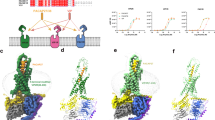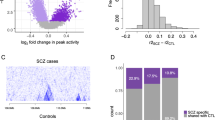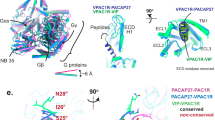Abstract
Submicroscopic structural variations, including deletions, duplications, inversions and more complex rearrangements, are widespread in normal human genomes. Inverted segmental duplications or highly identical low-copy repeat (LCR) sequences can mediate the formation of inversions and more complex structural rearrangements through non-allelic homologous recombination. In a patient with 7q36 inverted duplication/terminal deletion, we demonstrated the central role of a pair of short inverted LCRs in the vasoactive intestinal peptide receptor gene (VIPR2)-LCRs in generating the rearrangement. We also revealed a relatively common VIPR2-LCR-associated inversion polymorphism disrupting the gene in almost 1% of healthy subjects, and a small number of complex duplications/triplications. In genome-wide studies of several thousand patients, a significant association of rare microduplications with variable size, all involving VIPR2, with schizophrenia was recently described, suggesting that altered vasoactive intestinal peptide signaling is likely implicated in the pathogenesis of schizophrenia. Genetic testing for VIPR2-LCR-associated inversions should be performed on available cohorts of psychiatric patients to evaluate their potential pathogenic role.
Similar content being viewed by others
Log in or create a free account to read this content
Gain free access to this article, as well as selected content from this journal and more on nature.com
or
References
Iafrate AJ, Feuk L, Rivera MN et al: Detection of large-scale variation in the human genome. Nat Genet 2004; 36: 949–951.
Sebat J, Lakshmi B, Troge J et al: Large-scale copy number polymorphism in the human genome. Science 2004; 305: 525–528.
Tuzun E, Sharp AJ, Bailey JA et al: Fine-scale structural variation of the human genome. Nat Genet 2005; 37: 727–732.
Zhang F, Gu W, Hurles ME et al: Copy number variation in human health, disease, and evolution. Annu Rev Genomics Hum Genet 2009; 10: 451–481.
Ciccone R, Mattina T, Giorda R et al: Inversion polymorphisms and non-contiguous terminal deletions: the cause and the (unpredicted) effect of our genome architecture. J Med Genet 2006; 43: e19.
Carvalho CM, Ramocki MB, Pehlivan D et al: Inverted genomic segments and complex triplication rearrangements are mediated by inverted repeats in the human genome. Nat Genet 2011; 43: 1074–1081.
Giorda R, Ciccone R, Gimelli G et al: Two classes of low-copy repeats comediate a new recurrent rearrangement consisting of duplication at 8p23.1 and triplication at 8p23.2. Hum Mutat 2007; 28: 459–468.
Malhotra D, Sebat J : CNVs: harbingers of a rare variant revolution in psychiatric genetics. Cell 2012; 148: 1223–1241.
Vacic V, McCarthy S, Malhotra D et al: Duplications of the neuropeptide receptor gene VIPR2 confer significant risk for schizophrenia. Nature 2011; 471: 499–503.
Levinson DF, Duan J, Oh S et al: Copy number variants in schizophrenia: confirmation of five previous findings and new evidence for 3q29 microdeletions and VIPR2 duplications. Am J Psychiatry 2011; 168: 302–316.
Bonaglia MC, Giorda R, Mani E et al: Identification of a recurrent breakpoint within the SHANK3 gene in the 22q13.3 deletion syndrome. J Med Genet 2006; 43: 822–828.
Zuffardi O, Bonaglia M, Ciccone R et al: Inverted duplications deletions: underdiagnosed rearrangements?? Clin Genet 2009; 75: 505–513.
Giglio S, Broman KW, Matsumoto N et al: Olfactory receptor-gene clusters, genomic-inversion polymorphisms, and common chromosome rearrangements. Am J Hum Genet 2001; 68: 874–883.
Osborne LR, Li M, Pober B et al: A 1.5 million-base pair inversion polymorphism in families with Williams-Beuren syndrome. Nat Genet 2001; 29: 321–325.
Giglio S, Calvari V, Gregato G et al: Heterozygous submicroscopic inversions involving olfactory receptor-gene clusters mediate the recurrent t(4;8)(p16;p23) translocation. Am J Hum Genet 2002; 71: 276–285.
Ravnan JB, Tepperberg JH, Papenhausen P et al: Subtelomere FISH analysis of 11 688 cases: an evaluation of the frequency and pattern of subtelomere rearrangements in individuals with developmental disabilities. J Med Genet 2006; 43: 478–489.
Gurrieri F, Trask BJ, van den Engh G et al: Physical mapping of the holoprosencephaly critical region on chromosome 7q36. Nat Genet 1993; 3: 247–251.
Lynch SA, Bond PM, Copp AJ et al: A gene for autosomal dominant sacral agenesis maps to the holoprosencephaly region at 7q36. Nat Genet 1995; 11: 93–95.
Novales MA, Fernandez-Novoa C, Hevia A et al: Partial trisomy for the long arm of chromosome 7. Case report and review. Hum Genet 1982; 62: 378–381.
Bartsch O, Vlcková Z, Erdogan F et al: Two independent chromosomal rearrangements, a very small (550 kb) duplication of the 7q subtelomeric region and an atypical 17q11.2 (NF1) microdeletion, in a girl with neurofibromatosis. Cytogenet Genome Res 2007; 119: 158–164.
Lehnen H, Maiwald R, Neyzen S et al: Severe phenotype in a girl with partial tetrasomy 7, karyotype 46,XX,trp(7)(q35q36). Cytogenet Genome Res 2009; 125: 248–252.
Lutz EM, Shen S, Mackay M et al: Structure of the human VIPR2 gene for vasoactive intestinal peptide receptor type 2. FEBS Lett 1999; 458: 197–203.
Brewer BJ, Payen C, Raghuraman MK et al: Origin-dependent inverted-repeat amplification: a replication-based model for generating palindromic amplicons. PLoS Genet 2011; 7: e1002016.
Giorda R, Beri S, Bonaglia MC et al: Common structural features characterize interstitial intrachromosomal Xp and 18q triplications. Am J Med Genet 2011; 155A: 2681–2687.
Schinzel AA, Brecevic L, Bernasconi F et al: Intrachromosomal triplication of 15q11–q13. J Med Genet 1994; 31: 798–803.
Wang J, Reddy KS, Wang E et al: Intrachromosomal triplication of 2q11.2–q21 in a severely malformed infant: case report and review of triplications and their possible mechanism. Am J Med Genet 1999; 82: 312–317.
Ungaro P, Christian SL, Fantes JA et al: Molecular characterisation of four cases of intrachromosomal triplication of chromosome 15q11–q14. J Med Genet 2001; 38: 26–34.
Roberts SE, Dennis NR, Browne CE et al: Characterisation of interstitial duplications and triplications of chromosome 15q11–q13. Hum Genet 2002; 110: 227–234.
Vialard F, Mignon-Ravix C, Parain D et al: Mechanism of intrachromosomal triplications 15q11–q13: a new clinical report. Am J Med Genet 2003; 118A: 229–234.
McCarthy SE, Makarov V, Kirov G et al: Microduplications of 16p11.2 are associated with schizophrenia. Nat Genet 2009; 41: 1223–1227.
Harmar AJ, Marston HM, Shen S et al: The VPAC(2) receptor is essential for circadian function in the mouse suprachiasmatic nuclei. Cell 2002; 109: 497–508.
Author information
Authors and Affiliations
Corresponding author
Ethics declarations
Competing interests
The authors declare no conflict of interest.
Additional information
Supplementary Information accompanies the paper on European Journal of Human Genetics website
Rights and permissions
About this article
Cite this article
Beri, S., Bonaglia, M. & Giorda, R. Low-copy repeats at the human VIPR2 gene predispose to recurrent and nonrecurrent rearrangements. Eur J Hum Genet 21, 757–761 (2013). https://doi.org/10.1038/ejhg.2012.235
Received:
Revised:
Accepted:
Published:
Issue date:
DOI: https://doi.org/10.1038/ejhg.2012.235
Keywords
This article is cited by
-
Definition and refinement of the 7q36.3 duplication region associated with schizophrenia
Scientific Reports (2013)
-
Search for missing schizophrenia genes will require a new developmental neurogenomic perspective
Journal of Genetics (2013)



